Interview by Ronda Green, PhD, WTA Chair, September 2017
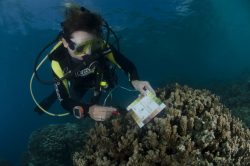
Coral Watch Photo by Chris Roelfsema
“The Reef is Dead”
“The Reef is fine!”
We hear a lot of extreme statements out there. What is really happening?
At one time the IUCN stated “ if only one coral reef site in the world were to be chosen for the World Heritage List, the Great Barrier Reef is the site to be chosen”. Since then there have been concerns about its continuing status as World Heritage into the future.
There are certainly still some wonderful experiences awaiting tourists on the Reef, so no one should cancel their holidays just yet, but there is obvious trouble already and more looming. Just how bad is it? Can we still do anything about it?
Professor Justin Marshall is an extensively-published and award-winning zoologist at he Queensland Brain Institute, University of Queensland who over several decades has conducted much research on marine animals of the Great Barrier Reef. His primary field of research is vision in marine animals but his frequent visits have given him ample opportunity to observe the quality of various parts of the reef and he has become increasingly concerned in recent years.
I interviewed Professor Marshall recently to learn more about what he has seen and his advice on what needs to be done.
Q. What has most disturbed you about the recent condition of our coral reefs?
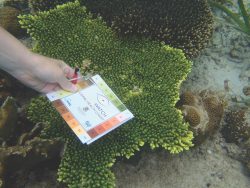
Photo by Coral Watch
A. The most alarming aspects is that this is a clear case not just of the loss of corals themselves but in some areas complete ecosystem collapse, including the loss of billions of fish. A lot of people don’t seem to realise that it is not just a case of corals bleaching and then perhaps recovering, but lots of other marine creatures that depend on them also dying. I’ve had the displeasure last year of swimming in a sort of soup of decaying marine life in what should have been a living reef. I came back from Lizard Island a couple of weeks ago. I only saw a few humbugs – those little stripy damsel fish – and one butterfly fish where there should have been hundreds of fish. There are people attempting to quantify all this at the moment, but I’m sort of over the actual numbers now, as it is clear that far too much has gone. It is like taking a walk in a forest where not only have the trees all lost their leaves and started falling over but the birds and other animals have also gone. If you examine the life in a tree scientifically you’ll also find a lot of small hidden creatures no oner thinks about, and they will have gone too. It’s the same on the reef: tiny creatures no-one really thinks about but important to the ecosystem also dying. So that’s the most alarming thing – that it is not just coral but a whole ecosystem collapse, and also of course the sheer scale of what is happening. We have already lost more than half the coral cover in the past 30 years and the rate of loss is now accelerating.
Q. Do you mean Lizard Island and other parts of the northern region, or the entire Great Barrier Reef?
A. The southern third of the reef is still in great shape, and if you want to see healthy coral reefs you can still go to places like Lady Elliot Island, but the loss of over 50% is based on the entire Reef. Lady Elliott was actually saved by cyclone Winston last year, which wasn’t really still a cyclone by the time it reached there, but it mixed the waters and also made the sky overcast for several days. Anyway, we now have less than 50% left of the entire Reef, and Lizard Island itself only has about 10% of the coral cover it used to have, and the same applies top about a hundred km north and south of it. They’ve recently had two cyclones and crown of thorns outbreaks and two bleaching in a row, and it’s now a very sad place. It’s a place I used to take my kids. I wouldn’t take them there now.
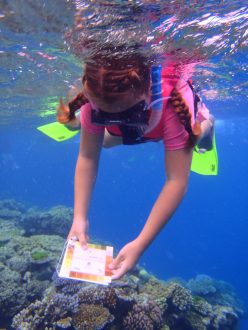
Photo by Coral Watch
A. The answer is not so much to do with water quality or diverting millions of dollars from another environmental problem to the Reef, but to run as fast as possible to renewable energy. We must become leaders again in environmental management, as it was when I started working on the Reef. We should be outstripping all other countries in this, but politicians that agree with this are not allowed to say anything against whatever their party says. Regarding the expansion of the coal industry, it is very disappointing to see a Labour government so strongly supporting something which every economist, every modeller, every mathematician looking at the future of the economy, sees and says “why are you doing that?” There are more jobs in tourism and in renewable energy development than in coal, so why is the government planning to waste x billion dollars on a railway that’s going nowhere? What’s going on? The responsible thing to do would be to say the coal industry is on the way out and we are developing programs to re-skill workers for industries of the future, and pump money into the development of renewable energy, because that’s the future of Queensland.
Q. Can the public (including tourists and tour operators) assist?
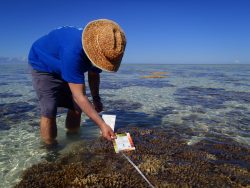
Photo by Coral Watch
Yes, in a number of ways. They can join activities in CoralWatch (www.coralwatch.org) which I started 15 years ago and which is now very focussed on positive solutions. We still need to keep monitoring, and visitors to the Reef can help with that, although we already know enough of the science to know the severity of the problem. More urgent now is the adjustment in lifestyle that is at the root of the solution to saving the reef. People often say “well what can I do? I can’t do anything. I’m just one person.” But you can be doing something simple at home and also help spread the word. The collective actions of many individuals is how things do get changed. Live sustainably, be as carbon-neutral as possible, install solar panels, don’t use plastic bags, don’t drive as much as you used to, try and have less children and so on. Coral Watch are producing a two page document, giving the actual facts, as opposed to there versions often given by the newspapers, and then suggesting what you can do about it. This is what has happened, and this is how we are going to fix it, not just relying on scientists and politicians to do so. People who want to look up how they can help, whether or not they can visit a coral reef, can visit Coral Watch, which has a lot of educational material with a focus on school kids. We must do something. Otherwise I feel that as a species we are saying to our kids “We’ve enjoyed a wonderful world but now we’ve stuffed it up and your future is in a desert. Bye.”
Q. Do you know about Wildlife Tourism Australia’s network of tourism operators involved in wildlife research?
A. No.
It involves networking between tour operators, because when Peter Wood and John Rumney studied operators involved in research they found too many of them didn’t know about each other. It also involves networking between operators and academic researchers who might be able to get free or discounted rides to research sites, park entries or accommodation. I’ve had to let it lapse a bit lately, but hoping to really start expanding it again soon with the help of some university students. If we don’t already have Coral Watch on our network I’ll certainly put it on soon .
A.
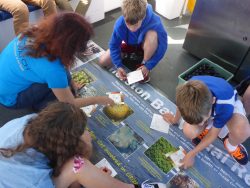
Photo by Coral Watch
Don’t think you can’t do anything as an individual. Run towards using renewables. You don’t have to give up everything. A sustainable future is a downhill pleasure now, not an uphill struggle. There are storage batteries. Look at what Elon Musk is doing. The University of Queensland and others are doing further research on the kinds of storage needed for different situations. Gatton campus is becoming carbon neutral and 100% sustainable. Other universities are also looking at how they can become more sustainable, but they are often also teaching mining. So a better future is possible if we do the right things, but we have to start doing them now.
Extra reading
- Coral Watch CoralWatch is a citizen science project based at The University of Queensland, in Brisbane, Australia. CoralWatch helps non-scientists around the globe understand and support effective reef management by using engaging tools that provide people with accessible information and hands-on-experience collecting scientific data about the health of corals using the Coral Health Chart. This chart standardises changes in coral colours, and provides a simple way for people to quantify coral health and contribute to the CoralWatch global database. The Coral Health Chart is used by dive centres, scientists, school groups, and tourists. To get involved simply download a Do it Yourself Kit, or the CoralWatch Apps (Android and Apple), request a Coral Health Chart and you are ready to start monitoring.
- Hughes T.P., et al. (2017a). Global warming and recurrent mass bleaching of corals. Nature 543: 373-377 Abstract:Coral reefs support immense biodiversity and provide important ecosystem services to many millions of people. Yet reefs are degrading rapidly in response to numerous anthropogenic drivers. In the coming centuries, reefs will run the gauntlet of climate change, and rising temperatures will transform them into new configurations, unlike anything observed previously by humans. Returning reefs to past configurations is no longer an option. Instead, the global challenge is to steer reefs through the Anthropocene era in a way that maintains their biological functions. Successful navigation of this transition will require radical changes in the science, management and governance of coral reefs.
- Hughes TP, et al. (2017b). Coral Reefs in the Anthropocene. Nature 546: 82-90 Abstract: During 2015–2016, record temperatures triggered a pan-tropical episode of coral bleaching, the third global-scale event since mass bleaching was first documented in the 1980s. Here we examine how and why the severity of recurrent major bleaching events has varied at multiple scales, using aerial and underwater surveys of Australian reefs combined with satellite-derived sea surface temperatures. The distinctive geographic footprints of recurrent bleaching on the Great Barrier Reef in 1998, 2002 and 2016 were determined by the spatial pattern of sea temperatures in each year. Water quality and fishing pressure had minimal effect on the unprecedented bleaching in 2016, suggesting that local protection of reefs affords little or no resistance to extreme heat. Similarly, past exposure to bleaching in 1998 and 2002 did not lessen the severity of bleaching in 2016. Consequently, immediate global action to curb future warming is essential to secure a future for coral reefs.
- Hughes TP, J. Day, and J. Brodie (2015). Securing the future of the Great Barrier Reef. Nature Climate Change 5: 508-511 Abstract: The decline of the Great Barrier Reef can be reversed by improvements to governance and management: current policies that promote fossil fuels and economic development of the Reef region need to be reformed to prioritize long-term protection from climate change and other stressors.
- Other references by Terry Hughes: https://www.coralcoe.org.au/person/terry-hughes
- ‘My job is to clean up the environment. China really wants to do that’ Article by J Gleeson-White in The Guardian, 10/9/17, Environmental lawyer James Thornton says China’s ‘ecological civilisation’ concept is the best response to the world’s environmental crisis
-
Lizard Island – A private paradise: article in Australian Traveller magazine [Paradise Lost now perhaps?]
-
Reid, C., Marshall, J., Logan, D. and Kleine, D. 2009. Coral Reefs and Climate Change The University of Queensland Press..
